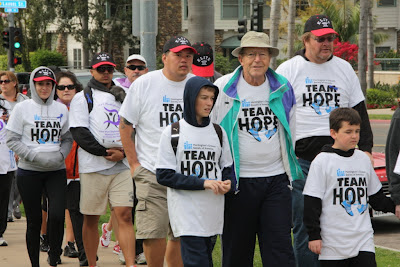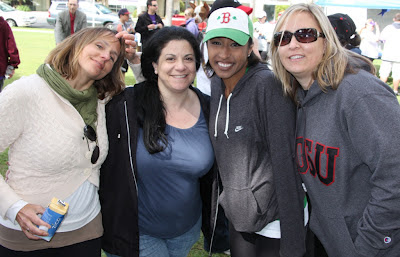One of my heroes is Stephen Hawking, the theoretical physicist who pioneered the science of black holes, Hawking radiation, the origins of the universe, and the quest for a “theory of everything,” an explanation of the ultimate forces and laws that govern the universe.
Hawking achieved all of this while surviving five decades with ALS, amyotrophic lateral sclerosis, known in the U.S. as Lou Gehrig’s disease and in Hawking’s native England as motor neuron disease. As is well known, ALS has completely paralyzed Hawking’s voluntary muscles, relegating him to existence in a motorized wheelchair with an on-board computer through which he speaks.
 Hawking at the White House with President Barack Obama in 2009 (photo from www.hawking.org.uk)
Hawking at the White House with President Barack Obama in 2009 (photo from www.hawking.org.uk)When doctors diagnosed Hawking with ALS in his early 20s, they gave him two years to live. However, through sheer determination and with the support of his devoted wives and numerous friends and nurses, Hawking not only survived but achieved remarkable accomplishments. On January 8 he celebrated his 70th birthday.
Like millions around the globe, I am awed by Hawking’s brilliance, moved by his triumph over ALS, and cheered by his good humor and kindness.
I have just finished Stephen Hawking: An Unfettered Mind, a new biography by Kitty Ferguson.
It richly details Hawking’s extensive achievements in physics and his views of the origins of the universe, including the question of God. Reading about Hawking and his ideas, I feel the enormousness of the universe and, as he does with ALS, put the disease that claimed my mother, and that I face, in a healthy perspective.
An Unfettered Mind also portrays Hawking’s struggles with ALS, his utter dependence on caregivers for survival, and his and his first wife Jane’s fight to improve life for the disabled.
For HD activists, I believe that Hawking’s life offers valuable lessons to help strengthen our resolve to fight and demand better care for HD patients.
The ravages of ALS
Whereas HD is a fully genetic disease, only about ten percent of ALS cases are inherited. Researchers do not know the cause of the other 90 percent.
Like HD, ALS is debilitating and deadly. As Ferguson points out, ALS causes disintegration of the nerve cells in the spine and brain that regulate voluntary muscle activity. The muscles controlled by these nerve cells atrophy. Eventually every voluntary muscle in the body becomes compromised, making movement of any kind impossible. After diagnosis, most ALS patients live only a few years, dying from pneumonia or suffocation.
Patients experience no pain, and, unlike with HD, remain lucid to the very end. As Ferguson explains, patients in the final stage are prescribed morphine for panic and depression.
Hawking’s symptoms began as clumsiness during his third year as an undergraduate at the University of Oxford. Upon starting graduate studies at the University of Cambridge, he had difficulty tying his shoes, and his speech started becoming slurred.
Hawking experienced frequent fits of choking. In the summer of 1966 his fingers started to curl; writing by hand became almost impossible. A few years later he started using crutches. It took him 15 minutes just to climb the stairs at home. By 1971 he needed a wheelchair.
By the time Hawking became Cambridge’s Lucasian Professor of Mathematics – a chair also held by Isaac Newton – he “could no longer walk, write, feed himself, or raise his head if it tipped forward,” Ferguson writes of his condition in 1979. “His speech was slurred and almost unintelligible except to those few who knew him best.”
Hawking had several brushes with death. One occurred during a 1985 trip to Switzerland, where he became so ill that the doctors put him into an induced coma and on a life-support system. In order to save his life, Jane decided to have him undergo a tracheotomy, which was performed in Cambridge.
Hawking could no longer speak and could only communicate by spelling out words letter by letter; a helper would point to the letters on cards held out for him to see and select with a nod. Also, Hawking now needed 24-hour care from nurses.
Ferguson recounts how a computer expert in California enabled Hawking to communicate more rapidly by giving him a program the man had invented called “Equalizer.” It allowed Hawking to select words from a computer screen, and it also had a voice synthesizer – the famous Hawking voice known around the world. A student made Hawking a mouse-like tool that allowed him to operate the computer by squeezing a switch with his hand.
Because ALS continues to destroy his muscles, today Hawking can no longer use the mouse-like device. He now operates the computer by twitching a cheek muscle and thus activating a low-power infrared beam that prompts the computer.
“It is, of course, nothing short of miraculous that Hawking has been able to achieve everything he has, even that he’s still alive,” Ferguson concludes. “However, meeting him and encountering his intelligence and humor, you find yourself taking his unusual mode of communication and his obviously catastrophic physical problems no more seriously than he seems to himself. That is the way he wants it. He chooses ‘not to think about my condition, or regret the things it prevents me from doing, which are not that many.’ He expects others to adopt the same attitude.”
Although ALS has destroyed his body, Hawking plans to make further contributions to science. In a documentary produced several years ago, he declared through his voice synthesizer: “Hello. My name is Stephen Hawking: physicist, cosmologist and something of a dreamer. Although I cannot move, and I have to speak through a computer, in my mind I am free.”
Personal and institutional supports
In Ferguson’s account, Hawking has thrived so long only with the love and support of Jane and his three children with her. (ALS patients can still have sex.) Numerous professional colleagues, friends, the nurses, and other caregivers and assistants also provided Hawking with crucial support.
In the early years of the marriage, Jane cared for Hawking and coordinated the fulfillment of his needs. An intellectual in her own right, she postponed her graduate studies in literature, and she usually kept in the background as Hawking acquired accolades and fame. Ferguson reflects on how Jane chose this life path at a time when the feminist movement influenced many women to strike out independently of their husbands.
Hawking’s disease and success, as well as the presence of large number of caregivers in the home, made his marriage to Jane far from conventional. Although Ferguson does not discuss the Hawkings’ sex life during the period that they conceived their children, she does explore their ever more unusual and complex emotional and familial relationship as they lost physical intimacy. Both had affairs, and Hawking later married one of his caregivers, Elaine Mason. They divorced in 2006 amidst rumors of abuse by Elaine. At the time, Hawking refused to comment on the divorce. Ferguson indicates that no abuse took place. “The bottom line was ‘He loves Elaine,’” she concludes.
HD families also develop in highly complex ways. In addition to the debilitating symptoms, stigma, denial, and anger can lead both patients and caregivers to act aggressively, sometimes resulting in divorce or the splitting of extended families in disagreement about how to confront the disease.
However, I want to emphasize Jane’s decades-long support of her husband, and also how the family, friends, and colleagues rallied around Hawking in his battle against ALS.
The nursing staff played an especially important part. As Ferguson describes, the nurses made Hawking look nice by brushing his hair, polishing his glasses, and wiping his chin of the saliva that ran out of his mouth. They also spoon-fed him. Most importantly, they regularly cleared his throat with a “mini-vacuum cleaner” so that secretions did not build up in his lungs.
Institutional support was also crucial for both Hawking’s survival and scientific success. The British National Health Service would not pay for his 24-hour care, which the family naturally could not afford. The MacArthur Foundation, which funds academic research and other projects, came to the rescue with a grant to pay for the home care.
Ferguson points out that without such care Hawking would likely have languished in a nursing home.
Hawking’s fame and success have brought him almost endless privileges. Since 2000, he has flown frequently by private jet (paid for by others). In difficult situations, people and governments have made special accommodations for his disability.
Most disabled people can only dream of such special treatment.
The Hawkings’ advocacy
Nobody begrudged Hawking these wonderful advantages.
Recognizing the need to improve the plight of all disabled people, the Hawkings successfully pushed for greater institutional access for wheelchairs – a major struggle in the 1970s that is now often forgotten. “The Hawking image encouraged universities to set up dormitories equipped for students needing round-the-clock nurses in order to attend classes,” Ferguson writes.
Hawking firmly advocated that disabled children always be grouped with normal children of the same age.
Yearning for freedom for HD people
As Hawking’s mind remains free, I am fighting to keep my own mind free, along with thousands upon thousands of HD patients and gene-positive individuals.
In contemplating Hawking’s life, I fantasized about how wonderful it would have been for my mother to have had a device that allowed her to communicate with us from behind the horrible, impenetrable mask of Huntington’s disease.
At 52, I have reached my mother’s age of onset: each day I worry that Huntington’s will cut short my career as a college professor and writer and leave me unable to love and support my family as my daughter approaches adolescence and prepares to enter an expensive private school next fall.
Sadly for most HD people, Huntington’s destroys the area of the brain responsible for speech, thought, and memory.
Redoubling efforts for better care
The first effective treatments could arrive within the next five to ten years, but until then the HD community must focus on providing for – and demanding an improvement in – care for our stricken loved ones.
This will require us to redouble our efforts to change the nation’s outdated Social Security rules for HD people (click here to read more); provide Medicaid assistance without forcing couples to divorce and impoverish the sick individual to make him or her eligible; implement better standards of care as widely as possible; demand assistance for families caring for HD people in the home; and insist on better nursing home care. The lack of competent nursing home care remains one of the most intractable problems faced by HD families.
For now, this is our best hope for prolonging the lives of our loved ones and making their final years and months as comfortable as possible.
Perhaps HD people cannot have the advantages of a 24-hour team of expert nurses. But Hawking’s privileges point to a horizon of healthiness that humanity should aspire to for all disabled and ill people.
HD people have as much right as Hawking or anybody else to fair, decent, and up-to-date care.
In this fight, we can take a cue from Hawking.
“It is no use complaining about the public’s attitude about the disabled,” he declared at a speech at the University of Southern California in 1990. “It is up to disabled people to change people’s awareness in the same way that blacks and women have changed public perceptions.”




